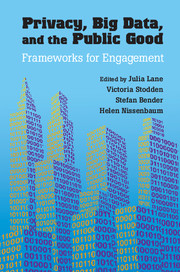Book contents
- Frontmatter
- Dedication
- Contents
- Contributors
- Editors’ Introduction
- Part I Conceptual Framework
- Part II Practical Framework
- 6 The Value of Big Data for Urban Science
- 7 Data for the Public Good: Challenges and Barriers in the Context of Cities
- 8 A European Perspective on Research and Big Data Analysis
- 9 The New Deal on Data: A Framework for Institutional Controls
- 10 Engineered Controls for Dealing with Big Data
- 11 Portable Approaches to Informed Consent and Open Data
- Part III Statistical Framework
- References
11 - Portable Approaches to Informed Consent and Open Data
Published online by Cambridge University Press: 05 July 2014
- Frontmatter
- Dedication
- Contents
- Contributors
- Editors’ Introduction
- Part I Conceptual Framework
- Part II Practical Framework
- 6 The Value of Big Data for Urban Science
- 7 Data for the Public Good: Challenges and Barriers in the Context of Cities
- 8 A European Perspective on Research and Big Data Analysis
- 9 The New Deal on Data: A Framework for Institutional Controls
- 10 Engineered Controls for Dealing with Big Data
- 11 Portable Approaches to Informed Consent and Open Data
- Part III Statistical Framework
- References
Summary
Introduction
What frameworks are available to permit data reuse? How can legal and technical systems be structured to allow people to donate their data to science? What are appropriate methods for repurposing traditional consent forms so that user-donated data can be gathered, de-identified, and syndicated for use in computational research environments?
This chapter will examine how traditional frameworks for permitting data reuse have been left behind by the mix of advanced techniques for re-identification and cheap technologies for the creation of data about individuals. Existing systems typically depend on the idea that de-identification is robust and stable, despite significant evidence that re-identification is regularly possible on at least some portion of a de-identified cohort. The promise that privacy can always be protected, that data can always be de-identified or made anonymous, is at odds with many of the emerging realities of our world.
At issue here is a real risk to scientific progress. If privacy concerns block the redistribution of data on which scientific and policy conclusions are based, then those conclusions will be difficult to justify to the public who must understand them. We must find a balance between our ability to make and produce identifiable data, the known failure rates of de-identification systems, and our need for policy and technology supported by ‘good’ data. If we cannot find this balance we risk a tragedy of the data commons in which the justifications for social, scientific, and political actions are available only to a select few.
- Type
- Chapter
- Information
- Privacy, Big Data, and the Public GoodFrameworks for Engagement, pp. 234 - 252Publisher: Cambridge University PressPrint publication year: 2014
References
- 5
- Cited by



